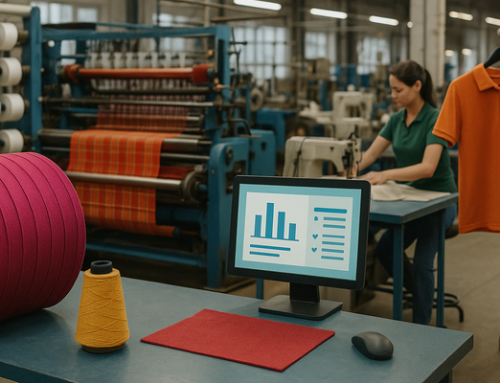Enhancing Textile Production with CAMS and Real-Time Data
Did you know that the time it takes to make garments has decreased from weeks to only a few days thanks to CAMS (Computer Aided Manufacturing Systems)? Not only: the fabric and garments that are produced are of first quality, without defects and errors, each piece can be traced at every stage of the production process.
This leap demonstrates how real-time data and CAMS are revolutionizing the textile industry. Textile companies are improving their efficiency, resource management, and product quality by utilizing cutting-edge software such as CAMS fully integrated to the planning and inventory functions within the ERP system.
As textile producers embrace the power of Computer Aided Manufacturing and real-time data, they gain not only operational efficiency but also contribute to sustainability goals by reducing waste and using resources more effectively. The future of textile manufacturing is NOW, and with tools like CAMS, it’s not just about speed, it’s about making smarter, more sustainable decisions.
What is Computer Aided Manufacturing?
CAM – Computer-Aided Manufacturing refers to the use of software to control and automate manufacturing processes. In textile production, CAM systems like Datatex CAMS enable real-time monitoring, data collection, and precise control over machinery to enhance efficiency and quality.
CAMS is a crucial component of Datatex‘s Textile and Apparel ERP, which is intended to identify, document, and gather all aspects of textile production in real time. This module reduces the need for manual checks by connecting directly with machines to record production progress.
Textile and Apparel Manufacturing process works faster and more flexible with CAMS, because CAMS keeps production lines operating smoothly and efficiently by anticipating when machines require maintenance, which reduces downtime and operating expenses.
By controlling crucial procedures like weighing, labeling, packaging, and palletizing while maintaining machine and operator alignment, CAMS also increases productivity.
The Role of Real-Time Data in Modern Textile Manufacturing
In today’s competitive textile environment, the importance of real-time data cannot be overstated. Manufacturers are required to make faster, more accurate decisions, and this demand is driving the adoption of technologies that provide immediate insights so companies could adapt quickly to market demands, providing a competitive edge.
Real-time automatic data collection enables manufacturers to monitor production processes continuously, making it critical for enhancing efficiency and productivity.
CAMS serves as an essential MES (Manufacturing Execution System) that facilitates this transformation, allowing textile manufacturers to integrate data from various stages of production into a cohesive system that enhances visibility and control over operations.
Why Real-Time Data Matters on the Shop Floor?
Collecting real-time production data directly from machines can significantly transform textile and garment manufacturing. By automating data capture, CAMS reduces human error and improves productivity, minimizing downtime across the production line.
Real-time data provides immediate feedback, enabling operators to respond swiftly to any issues, such as machine malfunctions or production bottlenecks.
This immediacy allows for informed decision-making that can enhance overall production quality and efficiency, ultimately resulting in a more agile manufacturing process.
Creating the data base with all information will provide the platform for the use of AI.
Overcoming Common Challenges in Textile Production with MES
Textile producers often face challenges such as manual data entry errors, production delays, bottlenecks, and unexpected downtime due to machine issues. These pain points can hinder productivity and lead to increased costs.
CAMS addresses these challenges by automating data collection and monitoring machine status. By integrating these processes into a cohesive textile MES, manufacturers can optimize operator productivity and ensure smoother operations. With CAMS, real-time alerts and reporting help teams stay proactive in managing their production environments.
With the help of a configuration tool that defines the screen layout and the program’s functional flow, the highly configurable and parameterizable Datatex CAMS application may be set up and customized during the deployment phase to meet the requirements of the business process.
Real-Time Insights Across the Manufacturing Process
The broader benefits of real-time reporting extend beyond individual workstations to encompass the entire manufacturing process. Managers can track productivity metrics, adjust production flows, and implement improvements based on real-time insights.
With CAMS, manufacturers maintain close oversight of every stage, from raw materials to finished goods, ensuring that all processes align with production goals. This end-to-end visibility not only helps in maintaining quality standards, but also supports strategic planning and resource allocation.
This allows managers to take proactive and data-driven decision-making steps for further production enhancements.
Boosting Productivity with Smarter Workflows
Automating workflows through systems like CAMS significantly enhances operator efficiency and machine performance. Features such as job queue management and automatic downtime detection streamline operations and improve overall productivity.
Faster production cycles lead to quicker order fulfillment and greater customer satisfaction.
By tracking production progress in real time, manufacturers can quickly identify inefficiencies and make necessary adjustments. This proactive approach allows for continuous improvement in production workflows, resulting in higher output and reduced waste.
The Future of Textile Manufacturing with Advanced Textile MES Solutions
As we look to the future, the integration of advanced MES solutions like CAMS in textile ERP systems, will play a pivotal role in shaping the textile manufacturing landscape.
These tools will offer greater automation, adaptability, and real-time insights, ensuring that manufacturers can respond effectively to evolving market demands.
By leveraging these advanced technologies and features like AI-driven predictive maintenance or IoT connectivity, textile producers can not only enhance their operational capabilities but also remain competitive in a fast-paced industry.
Conclusion: Real-Time Data is the Key to Staying Competitive
In summary, the value of real-time data in textile production is undeniable. MES solutions like CAMS enhance productivity, improve decision-making, and provide manufacturers with the tools they need to stay competitive.
By adopting smart, data-driven solutions, textile and garment manufacturers can streamline their operations, improve quality, and meet sustainability goals, paving the way for a more efficient and innovative future.
Visit our pages and learn more about CAMS, NOW integrations and Integrated ERP/MES solutions that will help you elevate your production capabilities and navigate market demands with confidence. Download our free brochures and flyers to find out more and subscribe to our newsletter.



